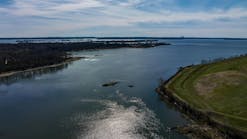About the author:
Katie Schaad is a supervising engineer with T&M Associates with a B.S. degree in Civil Engineering from Case Western Reserve University and over 14 years of experience. She has contributed to the design, construction, and management of many water and wastewater infrastructure projects. In 2018 with the support of her T&M team, Katie was able to set her daily duties to the side to help with FEMA’s Hurricane Harvey relief efforts. She deployed to Beaumont, Texas in 2018 to help communities increase infrastructure resiliency and obtain FEMA funding for mitigation projects. Schaad can be reached at [email protected].
As climate change intensifies, the United States has been battered by an increasing number of natural disasters. These disasters have extracted a painful toll in terms of lives lost and financial costs to communities. Between 1980 and 2020, disaster-related costs from events that included flooding, severe storms, drought, and wildfires rose from tens of billions to hundreds of billions of dollars per year, peaking at $450 billion in 2011 and 2018. And these figures may not even account for all indirect costs associated with lives lost, injuries, displaced populations, or conditions such as Post Traumatic Stress Disorder (PTSD), often caused by disasters.
Many of these are storm water-related disasters. Hurricane Harvey, for example, which devastated Texas in 2017, was America’s wettest tropical cyclone on record. The resulting floods inundated hundreds of thousands of homes, displaced more than 30,000 people, and prompted more than 17,000 rescues. The massive toll on lives, buildings and infrastructure, with damages totaling some $125 billion, also made Harvey the costliest tropical cyclone on record, tied with Hurricane Katrina in 2005.
Fortunately, there is a way for municipalities and the water resources community to help minimize the physical and financial devastation wrought by natural disasters. Hazard mitigation can prevent damage before natural disasters occur, saving lives, protecting property, preserving communities, and potentially saving communities billions of dollars each year. And with the correct expertise, planning, and implementation, hazard mitigation can be largely funded through Federal Emergency Management Agency (FEMA) grants.
What is Hazard Mitigation?
FEMA defines mitigation as “any sustained action taken to reduce or eliminate loss of life or property from the effects of natural hazards.” When implemented as part of a well-considered plan, it makes for a valuable investment. Studies by the National Institute of Building Sciences show that an average of $6, and perhaps as much as $11, is saved for every federal dollar spent on mitigation. In fact, many disaster-related costs are incurred simply because public infrastructure has not been updated to meet codes and standards, which is an important part of hazard mitigation.
FEMA’s Public Assistance program guidance includes the following hazard mitigation examples:
- dry floodproofing buildings
- elevating electrical or other critical components
- constructing floodwalls
- minimizing erosion
- elevating assets above expected flood levels
- using tie-down straps for roof-mounted equipment to resist wind loads
- elevating sewer access covers above expected flood levels or installing water-tight covers
- raising well heads above expected flood levels, and/or sealing,
- installing buttresses at raw water intakes
- installing submersible equipment
These examples are mitigation efforts that directly protect physical infrastructure. Risk identification, asset management, emergency preparedness education and disaster planning are also forms of hazard mitigation that municipalities can implement.
Hazard mitigation is an investment that will protect lives, property and infrastructure and help prevent injuries, illnesses, and conditions such as PTSD. It can also reduce environmental impacts and the loss of economic activity and services due to business disruption.
FEMA Grant Funding
While these measures almost always yield a high return on investment, they do cost money. Such funding may not be available, depending on a municipality’s financial situation. Fortunately, there is considerable FEMA funding for mitigation provided through these programs:
- The Building Resilient Infrastructure and Communities program, or BRIC, replaces the older Pre-Disaster Mitigation (PDM) program. BRIC has considerably more funding and allows a wider variety of applicants. $500 million was available for Fiscal Year 2020 applicants, and the application process has not yet opened for 2021.
- The Flood Mitigation Assistance program is intended to minimize flood claims under the NFIP (FEMA, 2020b) by focusing on repetitive loss properties.
- The “406 Mitigation” program, as it is commonly known, is part of the Public Assistance program authorized through Section 406 of the Stafford Act. This funding is for mitigation of damaged infrastructure to prevent repeat damage during the next disaster. The federal cost share is up to 75% for most applicants, and up to 90% for small, impoverished communities.For the communities hit by Hurricane Harvey, the federal cost share was 90% for all communities.
- The 404 Hazard Mitigation Grant Program is available to communities or utilities within the state affected by a natural disaster, but for infrastructure not damaged by that particular disaster.
Storm water mitigation often includes drainage system improvements to protect residential communities, businesses and roadways. Property acquisition and converting properties to floodplain has also been proven to reduce damages caused by flooding. FEMA grant money has been used on many types of storm water management projects across the country and could be used to reduce flooding in your community.
Water and wastewater distribution, collection and treatment facilities are also often impacted by large storm events and may have an edge when applying for grant funding. Water and wastewater infrastructure is critical to every community – emergency services, hospitals, nursing homes and schools need these utilities to function. Because they are so critical, water and wastewater utilities can demonstrate a high benefit to cost ratio and therefore create competitive applications for grant funding.
Unfortunately, many municipalities may not understand the FEMA funding process. Following a disaster, it is not uncommon for communities to miss out on funding opportunities as personnel struggle to process the devastation and have limited time for grant applications.
Obtaining Hazard Mitigation Funding for Your Community
Many of FEMA programs cover the costs for municipalities to hire outside consultants to complete this work. FEMA’s Public Assistance Program and Policy Guide specifically states that “Architectural, engineering, and design services for the approved scope of work, including hazard mitigation, are also eligible, provided the services are reasonable.” A skilled consultant can provide much-needed support to reduce the stress of learning a new grant application process. The right expert can also maximize funding received and accelerate project schedules, which may last for years.
The first and most crucial role of an outside consultant may be to create or update a community’s Hazard Mitigation Plan (HMP). An HMP documents vulnerable assets and mitigation strategies and helps develop the roadmap for implementing these strategies. It can also be critical to developing the budgets needed for this implementation.
Communities can apply for funding to develop an HMP and are required to have HMPs to be eligible for some of FEMA’s programs. Leaders should be heavily involved in their community’s HMP and work to include all types of hazards which could impact the community – including flooding of roadways, residential and commercial areas, businesses, and water and wastewater infrastructure into the plan.
An effective HMP should answer key disaster- and emergency-related questions. Does your utility have vulnerable components or processes which may be damaged during a natural disaster, like a Hurricane Harvey? What would the resulting costs entail? Can your utility obtain temporary generators or pumping capacity during an emergency? What if there is a short supply? An HMP that can answer these questions will help a community prepare for future disasters and create a competitive grant application.
With the right expertise and planning, hazard mitigation can be implemented before the next disaster strikes. Doing so can save lives and property and save communities a great deal of money.






